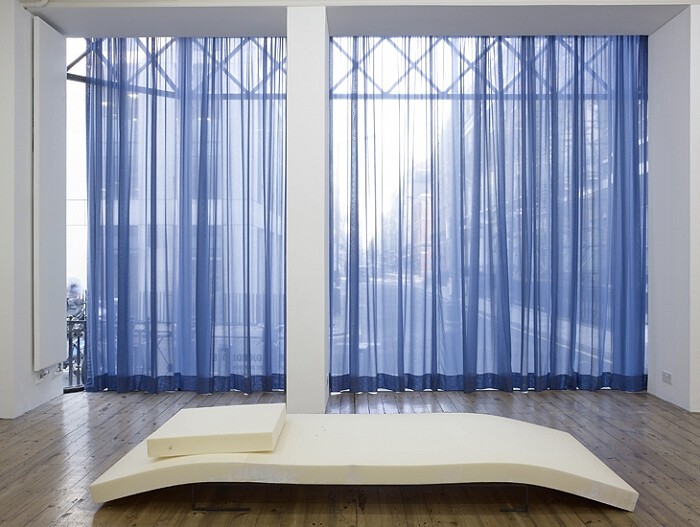Come inside and I will draw the curtains—shut out the streets and the harsh brightness of day in favor of dim bluish light. And we will find ourselves in a small beautifully proportioned room. You will immediately understand that this is a private space—an environment meant for one person or two. And what will we do here? What has been done before, in this building, located on a gentile Mayfair corner?
In her treatment of Sprüth Magers’s small London space, the Georgian artist Thea Djordjadze has created a psychologically freighted interior. The title “Spoons Are Different” shares a sense of near-familiarity with her work: forms of smudged clarity that we can almost read and fully comprehend, but not quite. As well as installing sets of long, sheer royal blue curtains in front of the gallery’s large windows, the artist has laid sculptures around the interior as though they were items of furniture designed for contemplative purpose. A steel sculpture, Untitled, (all works 2012), has the spindly two-legged proportions of a small desk, a bureau or even a tiny piano, as rendered in outline or frame, yet it is fixed to the wall at a skewed angle, one foot dangling in the air as if to push the point of its uselessness home. In the center of the floor is an ascetic divan—a pale yellow slab of foam slung over a low steel base with a small square pillow placed on top (just about big enough for spooning, you might think, if the exhibition’s title continues to echo in your mind), while, in the second part of this work, a high steel shelf stretches along the gallery’s back wall and around the corner, appearing to have been designed for books. A second yellow square of foam sits on this shelf, out of reach. The foam divan is covered in Djordjadze’s subtle white paint smudges here and there, resembling the mess picked up from an artist’s studio, yet there are also some drops of blue-green which stain the center of the bed. Given that the title of this work is Blue Dirt, it’s not long before you will start to see them as some kind of melancholic sexual effluvia or the lachrymose remains of depression.
The entire atmosphere of this blue room with its stained bed, unreachable bookshelf, and unusable desk is tinted with a very specific set of associations circling around intellectual endeavors and frustration and sexual sadness which bring a specific set of associations to my mind—the Berghof sanatorium of Thomas Mann’s The Magic Mountain; Vilhelm Hammershoi’s portraits of his wife playing the piano in austere pale blue-grey rooms; James Boswell’s diaries in which he endlessly struggles with his lack of discipline; Ian Kiaer’s sculptures which have mined related territory (and share an aesthetic register); Gwen John’s paintings of a blue-smocked girl reading or writing; and a recent novel, Ben Lerner’s Leaving the Atocha Station—all of which accompany a scattering of personal memories.
You might say that it is precisely the stripped back nature of these works that allow them to be filled with associations like mine listed above—like empty vessels waiting to have subjectivities poured into them, but Djordjadze’s installations often operate on a triangular structure which involves drawing elements from a specific environment as well as from her own formal concerns whilst also deploying a limited amount of suggestive elements that the viewer can follow and embellish on. Her site-specific work in a large greenhouse in Documenta (13), in which soil beds and cases could be read as flower beds, graves, and simple beds for sleep is a recent high-profile example of her approach.
You might look to the title of Djordjadze’s installation in the second, smaller back room—Tickle the Sketch—for a useful description of the relationship that one is drawn into by her work. A carpet in a rich primrose yellow hangs on the back wall before running down across the floor, which causes it to resemble a kind of backdrop and creates the feeling of a photographic studio, thereby disabling the previously established atmosphere of privacy. Three more steel-frame sculptures complete the installation, and here again, their shapes seem to refer to outdoor spaces rather than indoor furnishings: one sculpture frames the shape of the steps outside that you climbed to enter the gallery and another resembles a shop or restaurant sign. A third steel frame appears to be clambering up the yellow carpet on the wall, tickling it with its skinny metal feet. This is a more playful environment, and yet it is as disquieting as the first, for at the center of this private space we appear to have a kind of image factory in which images can be staged (the backdrop) and sold (the shop sign): the new public face of private lives that millions of social network users know all too well. Djordjadze’s first show in London is modest in its ambitions—a domestic drama of sorts—but it is an artistic match played against the proportions and history of the gallery’s domestically proportioned Georgian space. And, as such, the show impressively gave account of two forms of interior life: one a shade of historic blue—melancholy, private, strange—and the other a shade of youthful yellow—smiling, public, and far, far stranger.






